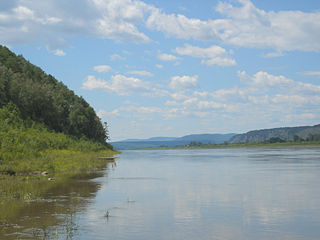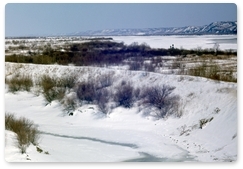
The Amur, or Heilong Jiang, is the world's tenth longest river, forming the border between the Russian Far East and Northeastern China. The Amur proper is 2,824 kilometres (1,755 mi) long, and has a drainage basin of 1,855,000 km2 (716,000 sq mi). Including its source river Argun, it is 4,444 km (2,761 mi) long. The largest fish species in the Amur is the kaluga, attaining a length as great as 5.6 metres (18 ft). The river basin is home to a variety of large predatory fish such as northern snakehead, Amur pike, taimen, Amur catfish, predatory carp and yellowcheek, as well as the northernmost populations of the Amur softshell turtle and Indian lotus.

The Nanai people are a Tungusic people of East Asia who have traditionally lived along Heilongjiang (Amur), Songhuajiang (Sunggari) and Wusuli River on the Middle Amur Basin. The ancestors of the Nanai were the Jurchens of northernmost Manchuria.

The kaluga, also known as the river beluga, is a large predatory sturgeon found in the Amur River basin. With a maximum size of at least 1,000 kg (2,205 lb) and 5.6 m (18.6 ft), the kaluga is one of the biggest of the sturgeon family. Like the slightly larger beluga, it spends part of its life in salt water. Unlike the beluga, this fish has 5 major rows of dermal scutes and feeds on salmon and other fish in the Amur. They have gray-green to black backs with a yellowish green-white underbelly.

Coldwater fish can have different meanings in different contexts.

The lake minnow or swamp minnow is a Eurasian species of small freshwater cyprinid fish. It has a wide but disjunct distribution including parts of Europe and Asia.

Rhynchocypris is a genus of fairly small Eurasian cyprinid fishes. There are currently seven described species in this genus.

Abbottina rivularis is a species of ray-finned fish in the family Cyprinidae, the carps and minnows. It is native to China, Korea, and Japan. It has been introduced to the Mekong River Basin and it is also known from rivers in Turkmenistan.

The Japanese sturgeon, or Amur sturgeon is a species of fish in the family Acipenseridae found in the Amur River basin in China and Russia. Claims of its presence in the Sea of Japan need confirmation. The species has 11–16 dorsal, 34–47 lateral, and 7–16 ventral scutes. Their dorsal fins have 38–53 rays and 20–35 anal fin rays. They also have greyish-brown backs and pale ventral sides. The species could reach up to 3 m (9.8 ft) in length, and weight over 190 kg. The species is considered to be critically endangered.

Leuciscinae is a subfamily of the freshwater fish family Cyprinidae, which contains the true minnows.

Tsuru River or Tsuru-kawa River is a branch of the Sagami River of Honshu, Japan. It runs 26.3 kilometers in Yamanashi prefecture.
Liolope is a monotypic genus of trematodes, or fluke worms, belonging to the family Liolopidae. The only species is Liolope copulans.

Khingan Nature Reserve is a Russian 'zapovednik', located in the extreme south-east of the Amur River region of the Russian Far East. The reserve covers two types of habitat: the flat Arkharinskaya lowlands with abundant wetlands, and forested spurs of the Lesser Khingan mountains. In particular, Khingan Reserve was created to protect steppe and forest-steppe landscapes, and nesting sites of the endangered Red-crowned crane and the vulnerable White-naped crane. The reserve is situated in the Arkharinsky District of Amur Oblast.
Czekanowski's minnow is an Asian species of small freshwater cyprinid fish. It is found in Russia, China, Korea, and Mongolia.

The Chinese minnow is an Asian species of small freshwater cyprinid fish. It is found from the Amur rivers in the north to the Yangtze in China in the south.
The Balkhash minnow is an Asian species of small freshwater cyprinid fish.

Pseudaspininae is a subfamily of the freshwater fish family Leuciscidae, which contains the true minnows. It is also known as the Far East Asian (FEA) clade of minnows. As the name suggests, all members of this family are found in East Asia.













